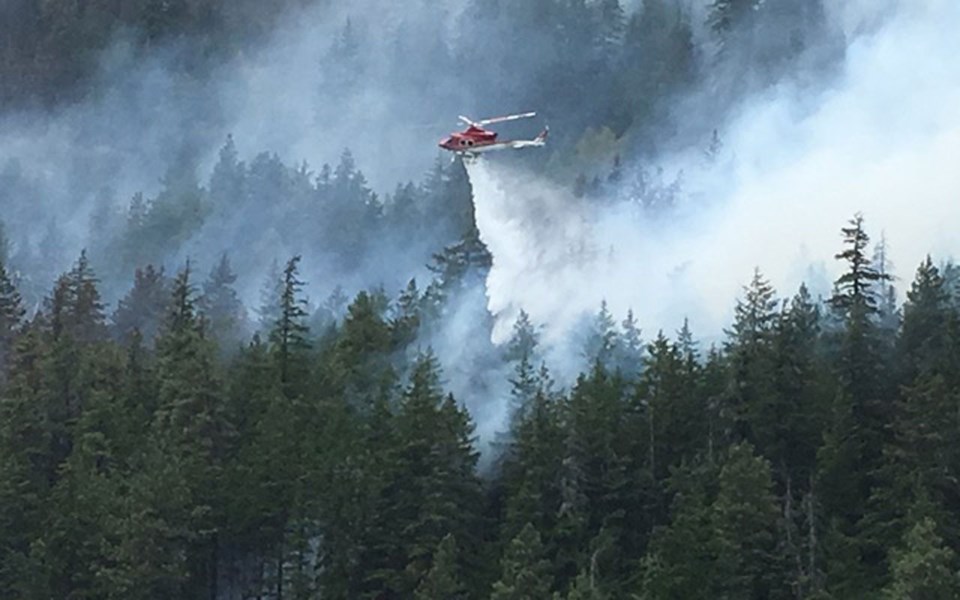Whistler has been enjoying some picture-perfect summer weather—so perfect that we probably aren't thinking much about the fact that a year ago, we were surviving in a hazy pall of wildfire smoke, and visits to resort destinations, like the Peak 2 Peak Gondola, were drastically down.
But the memories all came flooding back this week as we drove past the Resort Municipality's information sign on the highway at Lorimer Road warning about wildfire risk and telling us to be FireSmart.
Just a few weeks ago, we were watching a wildfire consume forest in the Anderson Lake area—a weekend retreat for many Whistlerites—hoping that our firefighters would get the upper hand. They did, thanks to the significant resources poured into fighting the fire, and a bit of help from Mother Nature, who sent several very wet days earlier this month.
Most parts of the province recorded average or above-average rainfall levels last month. That's a big improvement over last year, when a parched June helped set off the worst wildfire season in the province's history.
So far this year (April 2018 to March 2019), there have been 648 fires, with 50,802 hectares burned. On average, 60 per cent are caused by lightning and 40 per cent by people.
Wildfire risk has been top of mind for local government leaders for some years now. The Resort Municipality of Whistler (RMOW) has been working on wildfire risk reduction for over a decade with nearly $1.5 million budgeted for work this year (see Pique's cover feature page 40). Wildfire thinning work is being done in neighbourhoods including Alpine Meadows and Kadenwood, and a significant fire break is being put in place along the Callaghan Creek Forest Service Road to protect the resort from any blaze travelling up from the south.
In 2016, council commissioned a Wildfire Protection Strategy, which was completed by B.A. Blackwell & Associates, and outlined 17 recommendations to mitigate the risk in the long term—a multi-million-dollar plan.
Reading the plan, the cost seems prohibitive, but the report points to the cost of allowing a wildfire to rip through B.C.'s top tourist destination—and it calls for the province to step up with funding.
"Given the current shortfall in funding necessary to adequately protect the RMOW within the foreseeable future, to manage the current wildfire risk profile of the community, and to protect the significant contribution of the resort to the economy of British Columbia, additional support and funding certainty is required from the province," stated the report.
"Whistler currently welcomes over 3 million people per year, generates $1.5 billion annual provincial GDP and contributes approximately 25 (per cent) of BC's total tourism export revenue.
"The loss of forest cover and the impact to the built environment and critical infrastructure due to a wildfire would create a long term negative impact on the tourism experience of Whistler, and place significant downward pressure on visitor numbers and tourism revenues to the province."
The Protection Strategy report found that there is about 4,000 hectares of high-hazard crown land within the municipal boundary, and another 1,149 hectares within 500 metres of the structures in the core built-up area there of the resort.
And, of course, there are all the mature trees and growth in our lovely neighourhoods—greenery that is cherished by homeowners despite its obvious hazard in a wildfire situation.
Obviously, there is a lot still to do as we tackle the risk of wildfire in our community—this is not something we can allow to fall to the sides of our desks: Learn about fire-proofing your home (www.whistler.ca/firesmart), when you are in the backcountry, be responsible and if you see smoke report it immediately (dialling *5555 or 1-800-663-5555), and let's support our local government as it continues to put pressure on the province for more funding to try and prevent wildfire risk in our community.
Consider the stats in that report: the RMOW is more than 24,000 hectares in size and more than 65 per cent of that is forested. There are more than 9,200 homes. Look out your windows and see how you can help.




